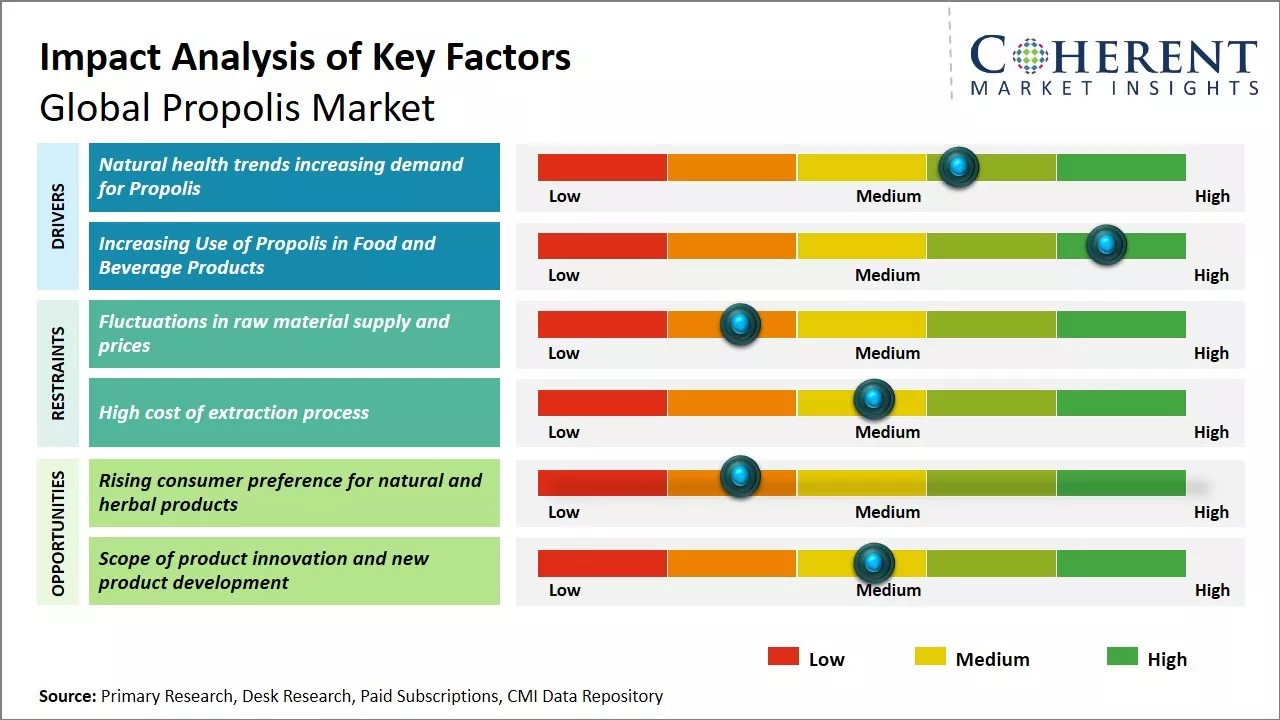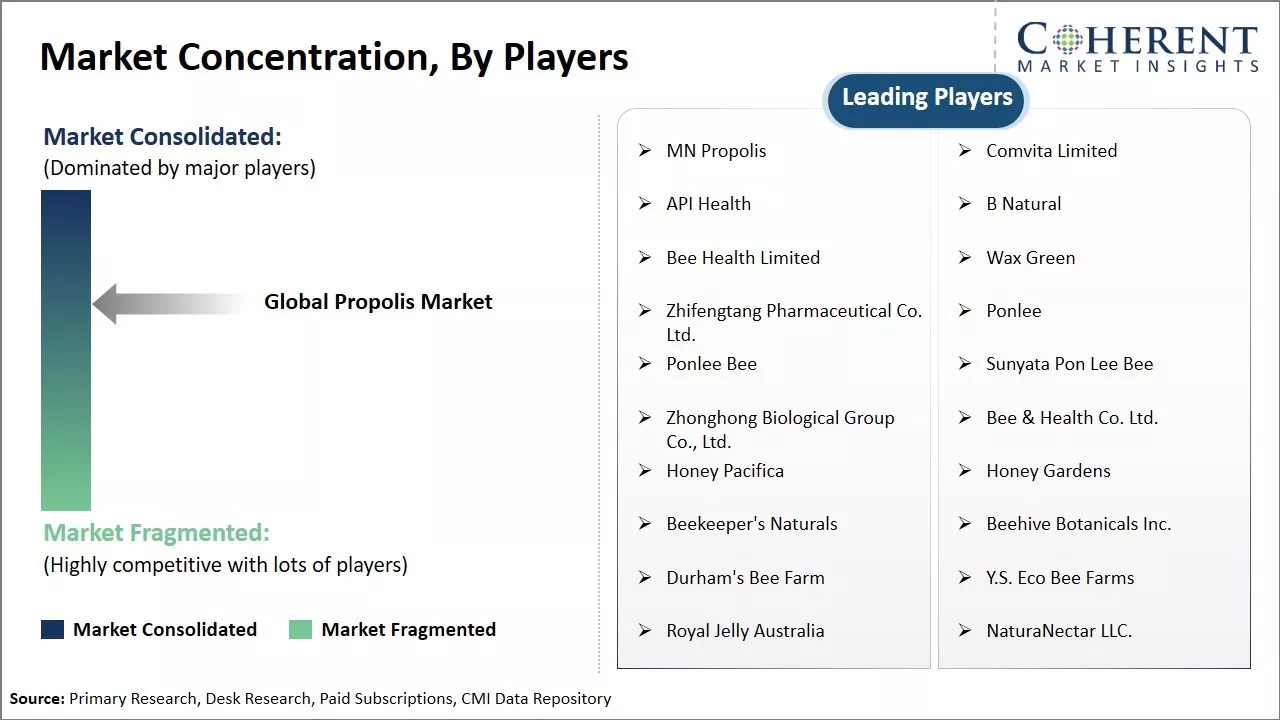The global propolis market is estimated to be valued at USD 701.3 Mn in 2025 and is expected to reach USD 840.0 Mn by 2032, growing at a compound annual growth rate (CAGR) of 2.6% from 2025 to 2032.

To learn more about this report, Download Free Sample
Propolis is used extensively in various industries like food and beverages, personal care & cosmetics, and pharmaceuticals. The increasing awareness about the health benefits of propolis is driving the propolis market growth. The demand for propolis is increasing globally due to growing consumer awareness regarding the health benefits offered by propolis. The increasing use of propolis in various applications like functional foods, dietary supplements, personal care products, etc. is expected to boost the market demand. The booming nutraceuticals industry and rising adoption of natural and herbal ingredients in food and cosmetics are some key factors that are expected to support the demand for propolis. However, stringent regulations regarding the use of propolis may hamper the market growth.
|
Current Events |
Description and its impact |
|
Global Climate Crisis and Bee Colony Collapse |
|
|
EU Regulatory Overhaul for Apiculture Products |
|
|
U.S.-Brazil Trade Tensions |
|
Uncover macros and micros vetted on 75+ parameters: Get instant access to report
Between September 2023 and August 2024 (TTM), India exported a total of 11 Propolis shipments. These were carried out by 3 Indian exporters and delivered to 8 international buyers, reflecting a 22% increase compared to the previous twelve-month period.
India primarily exports Propolis to countries such as Russia, Guyana, and Bulgaria.
On the global stage, South Korea, the United States, and Malaysia are the leading exporters of Propolis. South Korea tops the list with 1,415 shipments, followed by the United States with 311, and Malaysia in third place with 143 shipments.
Capsules and tablets represent the largest product type segment in the global propolis market due to several key advantages they offer consumers. This segment is expected to account for 62.8% of the market share in 2025. As a solid oral dosage form, capsules and tablets are highly portable and easy for consumers to carry with them throughout the day. Their compact size means they take up little room in pillboxes, bags, or pockets. This convenience factor is important for busy, on-the-go lifestyles. Capsules and tablets also provide reliable and consistent dosing compared to liquid formulations. The exact amount of active ingredients is tightly controlled within each dose. This dosing precision gives consumers confidence they are receiving the proper quantity to achieve the intended health benefits.
For example, Beekeeper's Naturals has launched a new gut health supplement called B. Biome Complete Gut Health, which is powered by propolis.
Propolis Market Insights, by Distribution Channel - Retail Store contribute the highest share of the market owing to its expert advice & in-store guidance.
Retail stores is expected to account for 61.8% of the market share in 2025. Their dominance stems from innate advantages in purchasing experience compared to alternative channels like online or direct seller models. Retail stores allow consumers to conveniently evaluate products in-person before buying. Being able to inspect packaging, read ingredient listings and nutrition facts up close, and sometimes sample offerings gives shoppers more confidence in their selection. This hands-on browsing experience is not replicated through online or catalog shopping. Seeing and touching products stimulates additional sensory feedback that helps consumers connect more personally with items that seem suitable for their needs. Retail stores also stock a variety of brands and types of propolis supplements from which to choose. Consumers benefit from being able to compare multiple options side-by-side to identify characteristics like flavor profiles, dose amounts, Certified Organic status, and country of origin. For instance, in April 2025, The Wedderspoon Organic Group, a top Manuka honey brand, is drawing attention with its Propolis and Manuka Honey Throat Sprays, which recently earned a Health & Beauty Essentials Award. Wedderspoon has made its Propolis Throat Spray available at major retailers such as Whole Foods Market, Amazon, Cub, Earth Fare, and Natural Grocers.

To learn more about this report, Download Free Sample
Europe accounts the most prominent share of 38.3%. Consumers across Europe are increasingly choosing propolis-based products to support immunity and skincare, fueling steady market growth. Germany, France, and the UK drive demand, supported by strong wellness habits and high awareness of propolis’s natural benefits. Companies continue to expand the market by innovating with capsules, sprays, and cosmetic applications. EU regulatory bodies maintain strict quality and safety standards, which reinforce consumer confidence. Retail pharmacies and health-focused stores actively serve as the main distribution points throughout the region. For instance, Weleda has won recognition for its Skin Food Facial Cleansing Balm. Launched as part of the iconic Skin Food range, this organic skincare product features natural extracts and holds both UEBT and Natrue certifications. It includes upcycled vine leaves and propolis and is certified climate-neutral. Such innovations are propelling the propolis market revenue.
The U.S. and Canada are actively opting for plant-based supplements to support preventive health. They are turning to propolis for its antimicrobial and anti-inflammatory benefits, particularly for boosting immunity and overall wellness. Public education campaigns and clean-label marketing continue to build trust in these natural solutions. Meanwhile, beauty and personal care brands are incorporating propolis into serums, creams, and sprays to leverage its soothing, blemish-reducing, and skin-healing properties, meeting the growing demand for natural skincare products. For instance, Korean skincare brand CNP Laboratory, founded by dermatologists from Cha and Park Dermatology, is gaining traction on Amazon in the United States. As interest in Korean skincare continues to rise, CNP has launched its flagship lip mask, Propolis Lipcerin™, on the U.S. Amazon platform.
The U.S. Department of Agriculture (USDA) has allocated over $200 million towards initiatives supporting beekeepers and improving pollinator health. This support ensures the sustainability of propolis production and stabilizes the supply chain for manufacturers. Moreover, manufacturers highlight its antimicrobial, antioxidant, and anti-inflammatory benefits. U.S. producers apply advanced extraction methods like supercritical CO₂ to retain potent compounds. They develop probiotic-infused capsules, standardized powders, sprays, and oral care products to meet consumer demand for effective, high-quality, and transparent functional ingredients.
Indian consumers, particularly in urban areas, are adopting propolis-based supplements for their antimicrobial, antioxidant, and anti-inflammatory effects. Drawing inspiration from Ayurveda and preventive wellness, demand is rising in functional healthcare, dietary, and cosmetic products. Indian brands are actively adding propolis to creams, serums, lotions, and topical products, attracting clean beauty enthusiasts who seek plant-based skincare for its soothing, skin-healing, and blemish-reducing benefits.

To learn more about this report, Download Free Sample
| Report Coverage | Details | ||
|---|---|---|---|
| Base Year: | 2024 | Market Size in 2025: | USD 701.3 Mn |
| Historical Data for: | 2020 To 2024 | Forecast Period: | 2025 To 2032 |
| Forecast Period 2025 to 2032 CAGR: | 2.6% | 2032 Value Projection: | USD 840.0 Mn |
| Geographies covered: |
|
||
| Segments covered: |
|
||
| Companies covered: |
MN Propolis, Comvita Limited, API Health, B Natural, Bee Health Limited, Wax Green, Zhifengtang Pharmaceutical Co. Ltd., Ponlee, Ponlee Bee, Sunyata Pon Lee Bee, Zhonghong Biological Group Co., Ltd., Bee & Health Co. Ltd., Honey Pacifica, Honey Gardens, Beekeeper's Naturals, Beehive Botanicals Inc., Durham's Bee Farm, Y.S. Eco Bee Farms, Royal Jelly Australia, and NaturaNectar LLC. |
||
| Growth Drivers: |
|
||
| Restraints & Challenges: |
|
||
Uncover macros and micros vetted on 75+ parameters: Get instant access to report
Consumers worldwide increasingly favor natural, organic supplements and personal care products over synthetic alternatives. Propolis, known for its antimicrobial, antioxidant, and anti-inflammatory properties, fits well into this trend. Rising health awareness encourages people to seek plant-based wellness solutions. This growing demand pushes manufacturers to innovate with clean-label, eco-friendly propolis formulations, expanding its use in supplements, skincare, and functional foods. Transparency about sourcing and processing also becomes a critical factor influencing buyer decisions.
The propolis market benefits from continuous innovation in extraction methods and product formats. Advanced techniques like supercritical CO₂ extraction enhance the potency and purity of propolis extracts. Manufacturers develop diverse products such as capsules, sprays, powders, and topical formulations to meet different consumer preferences. Combining propolis with complementary ingredients improves efficacy and broadens application areas. This innovation boosts convenience, bioavailability, and appeal, helping brands attract health-conscious and beauty-focused consumers globally.
Growing consumer focus on immunity creates a strong opportunity for propolis products, given their natural antimicrobial and anti-inflammatory properties. Consumers seek supplements and functional foods that support overall health, especially in light of recent global health concerns. Brands can innovate by developing targeted immune-boosting formulas that combine propolis with vitamins and minerals, tapping into wellness trends. Educating consumers on propolis’s role in immune health can further boost market adoption and loyalty.
Share
Share
About Author
Sakshi Suryawanshi is a Research Consultant with 6 years of extensive experience in market research and consulting. She is proficient in market estimation, competitive analysis, and patent analysis. Sakshi excels in identifying market trends and evaluating competitive landscapes to provide actionable insights that drive strategic decision-making. Her expertise helps businesses navigate complex market dynamics and achieve their objectives effectively.
Missing comfort of reading report in your local language? Find your preferred language :
Transform your Strategy with Exclusive Trending Reports :
Frequently Asked Questions
Joining thousands of companies around the world committed to making the Excellent Business Solutions.
View All Our Clients